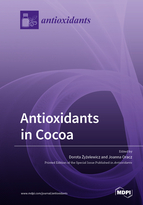Antioxidants in Cocoa
A special issue of Antioxidants (ISSN 2076-3921). This special issue belongs to the section "Natural and Synthetic Antioxidants".
Deadline for manuscript submissions: closed (30 June 2020) | Viewed by 55351
Special Issue Editors
Interests: cocoa beans; roasting; phenolic compounds; methylxanthines; tocopherols; phytosterols; Maillard reaction products; antioxidant capacities; isolation and characterization of bioactive compounds; nutraceuticals
Special Issues, Collections and Topics in MDPI journals
Interests: cocoa beans; acorns, roasting; phenolic compounds; methylxanthines; tocopherols; phytosterols; Maillard reaction products; melanoidins; antioxidant capacities; isolation and characterization of bioactive compounds; nutraceuticals
Special Issues, Collections and Topics in MDPI journals
Special Issue Information
Dear Colleagues,
Cocoa beans are the seeds of the tropical tree Theobroma cacao L. Because of the high concentration of bioactive compounds, including antioxidants (polyphenols, tocopherols), they are valued not only in the food industry but also in the pharmaceutical and cosmetic ones. In recent years, interest in these cocoa components has greatly increased because of their potentially beneficial effects on human health. Cocoa antioxidants can inhibit or delay cellular damage either by quenching free radicals or through chelation of transition metal ions, which reduces their capability to form reactive oxygen species. They also exhibit a wide range of physiological properties resulting in protection against diseases, including coronary heart diseases, cancer or neurodegenerative disorders. This Special Issue entitled “Antioxidants in Cocoa” will focus on the relevant current knowledge of cocoa antioxidants. Papers including research on any cocoa antioxidant (pure or in a formula—e.g., in food) in in vitro and in vivo studies are expected. Original research and review articles on the preventive and pro-health aspects of cocoa compounds with antioxidant properties for human and animal models in all basic, preclinical, clinical research are welcome.
Prof. Dr. Dorota Żyżelewicz
Dr. Joanna Oracz
Guest Editors
Manuscript Submission Information
Manuscripts should be submitted online at www.mdpi.com by registering and logging in to this website. Once you are registered, click here to go to the submission form. Manuscripts can be submitted until the deadline. All submissions that pass pre-check are peer-reviewed. Accepted papers will be published continuously in the journal (as soon as accepted) and will be listed together on the special issue website. Research articles, review articles as well as short communications are invited. For planned papers, a title and short abstract (about 100 words) can be sent to the Editorial Office for announcement on this website.
Submitted manuscripts should not have been published previously, nor be under consideration for publication elsewhere (except conference proceedings papers). All manuscripts are thoroughly refereed through a single-blind peer-review process. A guide for authors and other relevant information for submission of manuscripts is available on the Instructions for Authors page. Antioxidants is an international peer-reviewed open access monthly journal published by MDPI.
Please visit the Instructions for Authors page before submitting a manuscript. The Article Processing Charge (APC) for publication in this open access journal is 2900 CHF (Swiss Francs). Submitted papers should be well formatted and use good English. Authors may use MDPI's English editing service prior to publication or during author revisions.
Keywords
- Cocoa
- Antioxidants
- Polyphenols
- Tocopherols
- In vitro and in vivo antioxidant activity
- Mechanism of action cocoa antioxidants
- Synergistic interactions between cocoa bioactive components
- New cocoa antioxidant formulations








